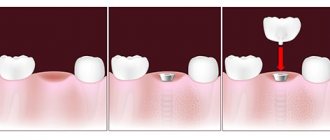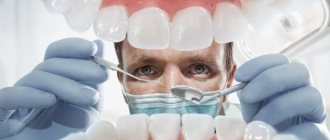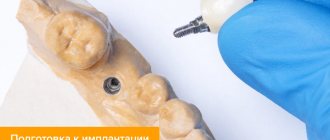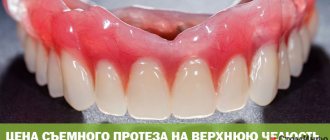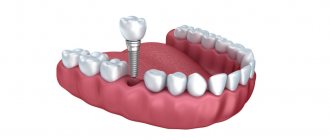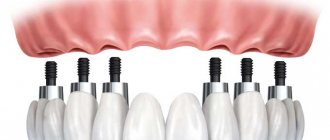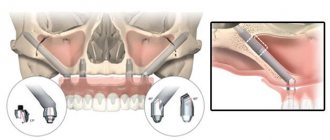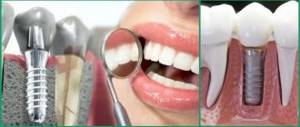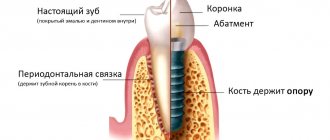In this article you will learn:
- types of dental prosthetics,
- which prosthesis is better for large absence of teeth,
- prices for dental prosthetics – for 2021.
Dental prosthetics is a branch of dentistry that deals with the restoration of damaged or missing teeth, the goal being to restore not only their appearance (their shape and aesthetics), but also their chewing efficiency. Dental prosthetics can be removable or non-removable. Fixed dental prosthetics are most often carried out with artificial crowns or bridges, which are fixed either to abutment teeth ground for crowns, or to dental implants.
Prosthetics in the absence of teeth or in the absence of a large number of them are most often removable. This means you can take your dentures out for cleaning and then put them back in again. However, now there are methods of prosthetics on implants, which, even if there are no teeth on the jaw, will allow you to get a completely permanent bridge prosthesis within 2-3 days after the operation. In this case, we are talking about the basal implantation technique, as well as implantation according to the All-on-4 protocol.
Example of dental prosthetics: before and after photos
Below we will analyze in detail fixed and removable dental prosthetics - types and prices in Moscow for each type of denture. Moreover, if you feel the need to insert teeth, you should always choose a non-removable prosthetic option, if possible, because no matter how good a removable denture is, it can fall off during conversation and when chewing, and the process of chewing food itself will not be very comfortable.
Moreover, in addition to traditional dental implantation, which allows you to obtain a fixed prosthesis even in the absence of teeth, there are also so-called mini-implants that are installed under a removable prosthesis to improve its fixation. Those. the prosthesis will still be removable, but it will be possible to remove it from the jaw only by applying significant force. The cost of dental prosthetics with a removable denture (on 4 mini-implants) is much cheaper than basal implantation or the All-on-4 technique, and will be only about 110,000 rubles.
From the history
The first developments on this project began in England in 2002 . For their experiment, the team used crowns from six-month-old piglets and rats .
The research team was led by Pamela Yelick. Immature dental tissue cells removed from piglets placed in enzymes.
Innovations in dentistry
After their formation, the cells were transferred to a polymer plate, which gradually decomposed during cell development. Fully formed rudiments were implanted into rats .
Exactly 3 months later, the rats had new crowns with defective dentin, a complete absence of enamel and an unformed root.
Based on previous research, the experiment was continued by scientists from the Tokyo University of Sciences in 2007 . Takashi Tsuji and his colleagues were able to grow new teeth and successfully implant them in young mice .
The newly grown organs fully performed their functions. They had formed dental tissues and lacked the root part.
The best result was achieved by the same group, but already in 2009 . For their research, Tokyo scientists used a different technology than what was used previously. To form the germ, they took mouse cells responsible for the development and growth of teeth , and stimulated their growth in a collagen environment.
After that, were planted in place of the removed crowns. In their place normal teeth grew with a complete crown and root part. During growth, a neurovascular bundle was formed , which is responsible for further nutrition of the dental tissue.
What effect does black toothpaste from Thailand have and where to buy it.
Popular Parodontax toothpaste: here is the description, composition and reviews.
Follow the link https://zubovv.ru/krasota-i-uxod/zubnyie-pastyi/roks-otzyivyi-vidyi-preimushhestva.html reviews about Rox “Active Calcium” toothpaste.
Genes
Scientists from the University of Zurich set out to identify the gene responsible for tooth growth. They found that the Jagged2 gene and a chromosome region called Notch . It was found that in the absence of activity of this gene, Notch begins to work with pronounced errors.
Based on the data obtained, scientists continued their research and isolated the gene responsible for the formation of the correct position of the crown - Osr2 . When it was deactivated, deformation of the dentition was detected with the growth of crowns beyond its limits, as well as the formation of a cleft palate.
Growing new teeth in humans artificially
Msx1 gene is responsible for initiating the formation of primordia . The experiment showed that in the presence of this gene and in the absence of others listed here above, single organs still developed. But when they were activated and Msx1 was turned off, no development of primordia occurred.
Based on the data obtained, scientists came to the conclusion that without the Msx1 gene, growing teeth is impossible.
Which crown to choose
Most of all, patients are interested in the cost of crowns and their aesthetics. Of course, you can choose a prosthesis yourself, focusing on your financial capabilities and ideas about beauty. But it is better if a doctor does this. Before starting the restoration of the dentition, the dentist evaluates the condition of the root system, gums, mucous membrane, tissues of the root part and cervical area. When choosing a prosthetic method, it is important to exclude all contraindications. They differ depending on the method of tooth restoration. The most serious are diseases of the immune system, oncology, uncompensated diabetes mellitus and periodontal inflammation. The doctor’s task is to choose the safest prosthetic option for the patient and the one that best suits the clinical picture.
Rudiments from stem cells
Professor Mitsiadis, after a detailed study of the relationship between gene activity and the development of rudiments, revealed that the genes responsible for their formation take an active part in the production of stem cells of dental tissues.
Based on this, some scientists began to believe that for abnormalities of a number of teeth caused by genetic factors, stem cells could be used as a restoration therapy.
These cells are the only ones that have the ability to restore damaged cells of the body, replacing them through their division.
To form a crown, a stem cell is planted in an empty alveolar socket and left alone. Over time, a new rudiment is formed there, and then a tooth .
At the same time, the growth process is accompanied by the same sensations as in childhood. The shape of the crown and root does not differ from real teeth.
The only caveat of this method is that with age the number of stem cells hopelessly decreases . If at the age of up to 25 years one can find one such cell per 100 thousand, then at 50 years there is 1 cell per 500 thousand.
In addition, the process of collecting material for cell isolation is very painful . Therefore, at the moment, scientists are more focused on developing methods that would make it possible to collect material more efficiently and less painfully.
Approximate price for tooth enamel extension using modern technologies.
Can Splat toothpaste solve dental problems? Here are reviews from dentists.
Why are brushes needed for cleaning teeth? Read https://zubovv.ru/krasota-i-uxod/ershiki-dlya-zubov/komu-neobhodimyi.html here.
Prosthetics of front teeth with veneers –
Dental veneers are microprostheses made of ceramic or composite filling material, which are used to cover the front surface of the teeth. Veneers can also eliminate problems with the color and shape of the front teeth, eliminate wide gaps between the front teeth, and thus they are a much more aesthetic, but also expensive alternative to light-polymer fillings (of course, if they are made of ceramic).
Ceramic veneers are the most aesthetic and high-quality. The best ceramic option in terms of aesthetics and reliability in this case would be the “E.max PRESS” material, but in a number of clinics veneers are also made from feldspathic ceramics (porcelain), or Noritake synthetic ceramics (Japan), or from zirconium dioxide with porcelain lining. Zirconium veneers are more expensive, but in terms of aesthetics they will be inferior to veneers from E.max PRESS.
Prosthetics of front teeth with veneers –
Insert teeth: prices for veneers made of ceramics and composites
- 1 porcelain veneer – about 15,000 rubles,
- 1 veneer E.max – from 21,000 to 28,000 rubles,
- 1 zirconium veneer – from 31,000 to 40,000 rubles.
There are also so-called composite veneers, which will be made from ordinary light-curing filling material - most often directly in the patient’s mouth (like a regular filling). The price for 1 unit will be from 6,000 to 9,000 rubles. And if ceramic veneers do not change their appearance over time, and their service life is limited only by the risk of mechanical injury, then composite veneers quickly change their appearance and will require replacement.
Animal experiments
Photo: growing a real living tooth
The stem cell complex was infused into mice. In order to be able to monitor the process in detail, green fluorescent protein, which is safe for the mice, was added to the cells.
This experiment ended with the appearance of a new tooth. The studies carried out showed the following:
- do not differ in shape from a real tooth;
- the anatomical structure included exactly the same elements : pulp, neurovascular bundle, dentin, enamel;
- dental tissues had high strength , allowing them to fully perform all functions;
- the size of the coronal part was slightly smaller than standard values.
This video talks about the methods by which scientists managed to achieve their first results:
Types of fixed dental prosthetics –
Fixed prosthetics can be used both to restore the destroyed crown part of a tooth using veneers, inlays or artificial crowns, and to restore missing teeth using bridges or using prosthetics on implants. Fixed prosthetics with veneers and crowns can also be performed for aesthetic reasons, for example, if the patient is dissatisfied with the color or shape of the front teeth.
Below we will look at the prices for dental prosthetics:
- crowns and bridges,
- supported by dental implants,
- veneers,
- removable and conditionally removable dentures.
Methods
In theory, there are 2 methods for growing human teeth: internal and external.
Interior
This method involves growing directly in the human oral cavity . The internal method was developed by a Ukrainian scientist and involves introducing stem cells into empty alveolar sockets. To do this, he suggests using cells isolated from fallen milk crowns .
They must be introduced under the mucous membrane by injection . Around 3 or 4 months, active cell proliferation and formation of the rudiment occurs. At the end of this period, a new tooth appears.
At the moment, this method is the simplest, but long-term. In addition, it never received a detailed study due to lack of funding.
Outer
The external method involves the formation of a tooth outside the oral cavity and then its further insertion into the alveolar bone socket for healing. To do this, they suggest using two growing methods:
- In organic culture. For this purpose, cells of a primitive type are used: mesenchymal and epithelial .
The combination of these cells is placed in a collagen scaffold to form the bud. Then the germ is transferred to an organic culture and after 2 weeks a tooth with enamel, dentin, blood vessels and pulp is obtained. These periods are typical for growing a mouse crown, the size of which was only 1.3 mm. - In a special test tube. In this case, exactly the same cells and the principle of embryo formation are used, but later it is placed not in organic matter, but in a capsule.
In order to ensure the growth of the crown, the capsule is implanted into the liver of the mouse. The timing of tooth formation in this case is no different from the first method.
Humanity will soon be able to grow new teeth on its own.
How is an implant inserted?
The essence of this technique is to implant a titanium root into the jaw, on which a crown is subsequently installed. On average, implant healing takes from 2 to 6 months. During this time, a temporary orthopedic structure is installed for the patient’s convenience.
There are protocols for immediate implantation. Modern structures can be inserted after tooth extraction and immediately loaded with a prosthesis. Many patients are interested in whether it is painful to insert a dental implant. In fact, implants are installed quite quickly (15 - 20 minutes per tooth), and an injection of anesthesia allows you not to feel pain. If you have severe dental phobia, the doctor will suggest inserting teeth under anesthesia or sedation.
Side effects
Despite the success of all recent research, these developments are still not being actively developed. This is primarily due to the side effects that may accompany this procedure.
When replanting a tooth or growing it, it is impossible to control the growth rate of each of its elements. In a normal process, the neurovascular bundle should develop at the same rate as dentin.
Otherwise, you can get an initially pathological crown , which can affect both the health of the oral cavity and any body systems.
There is also a problem associated with the body's immune response to the introduced cells. Perceiving them as foreign bodies, the immune system will reject them in every possible way.
To minimize the risk of such a situation, the patient will have to take serious dosages of immunosuppressants, which can completely deprive him of immunity for life.
The main disadvantage of the ongoing developments is the lack of a combined approach that would take into account all the nuances of this procedure and its consequences.
Criticism
Most scientists, even when studying already confirmed positive data, are of the opinion that these are useless, meaningless developments .
In their opinion, a single tooth growing in a mouse does not prove that stem cells will always behave as predicted.
In addition, these manipulations are associated with so many problems and questions that no scientist can yet solve.
Also, many are confused by the effectiveness of engraftment of an artificially obtained embryo. Not long ago, doctors made attempts to implant the patient’s own teeth from one part of the jaw arch to another.
This technique showed such a low survival rate that it was not widely used in dentistry. Judging by the unsuccessful result of this method, a grown tooth that differs little from your own may also simply not take root.
Many people are also confused by the fact that when replanting a germ, it is difficult to predict the type of tooth that will grow. For example, a molar or incisor will erupt in place of a fang.
One-stage implantation with immediate loading
Modern technology of accelerated dental implantation. This procedure allows you to restore your teeth almost immediately. Implantation according to this protocol is carried out without bone grafting, or with the simultaneous replanting of the patient’s own material, which accelerates cell regeneration, due to which bone tissue is restored in the shortest possible time.
In what situations is the procedure necessary:
- When the patient is unable to visit the same clinic for a long time. Many people specially come to another city for an appointment and do not have the opportunity to regularly visit the clinic. From this point of view, the accelerated implantation procedure is best suited
- In case of need for quick dental restoration. For people in creative or public professions, missing teeth can cost a career, and one-stage dental implantation will be an excellent solution to the problem.
- Missing several teeth in a row. In this case, there is a high risk of deformation of the jaw and healthy teeth due to increased load
Reference. If one or more teeth are missing, bone tissue atrophy develops as the jaw no longer receives the necessary load. This affects 95% of patients. The sooner the dentition is restored, the less deformation the bone tissue will be subjected to.
When will the service be available?
Encouraged by the positive result, Tokyo scientists began further study of this area. Today, they are successfully working on the differentiation of the created rudiments, which would allow precise positioning of the alveolar ridge section with the crown number.
New Dentistry of the Future: Growing Teeth
The scale and pace of research allowed scientists to assume that by 2030, the method of growing human teeth will become widespread and will gradually replace prosthetics and implantation.
Guarantees
Our Center uses implants with a lifetime guarantee - Nobel Biocare. We provide guarantees:
- 2 years for treatment;
- 1 year for prosthetics;
- lifetime for implantology.
Warranty obligations apply provided that the patient follows the doctor’s recommendations, rules of care and regularly visits the dentist. The warranty program includes a complex: for an implant, surgery, bone reconstruction and prosthetics.
Price
According to scientists, this technique will have the same cost as standard prosthetics using implantation, since its cost is not so high.
But if we take into account market marketing, then even if widespread, for at least 10 years after its appearance in clinics, this service will be the most expensive of all dental work .
If you find an error, please select a piece of text and press Ctrl+Enter.
Tags growing teeth scientific developments future technologies
Did you like the article? stay tuned
If you need to insert a tooth after it has been removed
The best solution to insert one tooth is a one-time implantation, but a tooth can only be inserted if too much time has not passed since its removal. To firmly fix the implant in the bone, the jaw bone tissue must be dense and have a certain height. But the longer a tooth is missing, the more the bone thins and dries out. Therefore, if you had a tooth removed several years ago, you can have it replaced either with prosthetics or classical implantation.
